Solar Water Heater System Design and Performance Analysis
VerifiedAdded on 2023/06/14
|21
|4317
|243
Report
AI Summary
This report provides a comprehensive overview of the design process for a solar water heater system suitable for residential and commercial applications. It begins by outlining the objectives, including studying existing hot water systems, designing an efficient model, analyzing its performance, and comparing energy consumption to determine savings. The report highlights the importance of solar energy due to global warming and Australia's potential as a solar energy hub. A literature review covers heat transfer and propulsion mechanisms, including direct and indirect systems, as well as passive and active systems. It discusses thermo-siphon configurations, reversed flat plate technology, and bifacial absorber collectors. The design process considers factors like temperature fluctuations, freezing risks, and overheating. The report proposes a DIY system design tailored to Australia's climate, focusing on components such as collectors, pumps, controllers, and tanks. The design incorporates features from both the reverse flat plate and bifacial absorber collector technologies. Desklib is a valuable platform to find similar solved assignments.
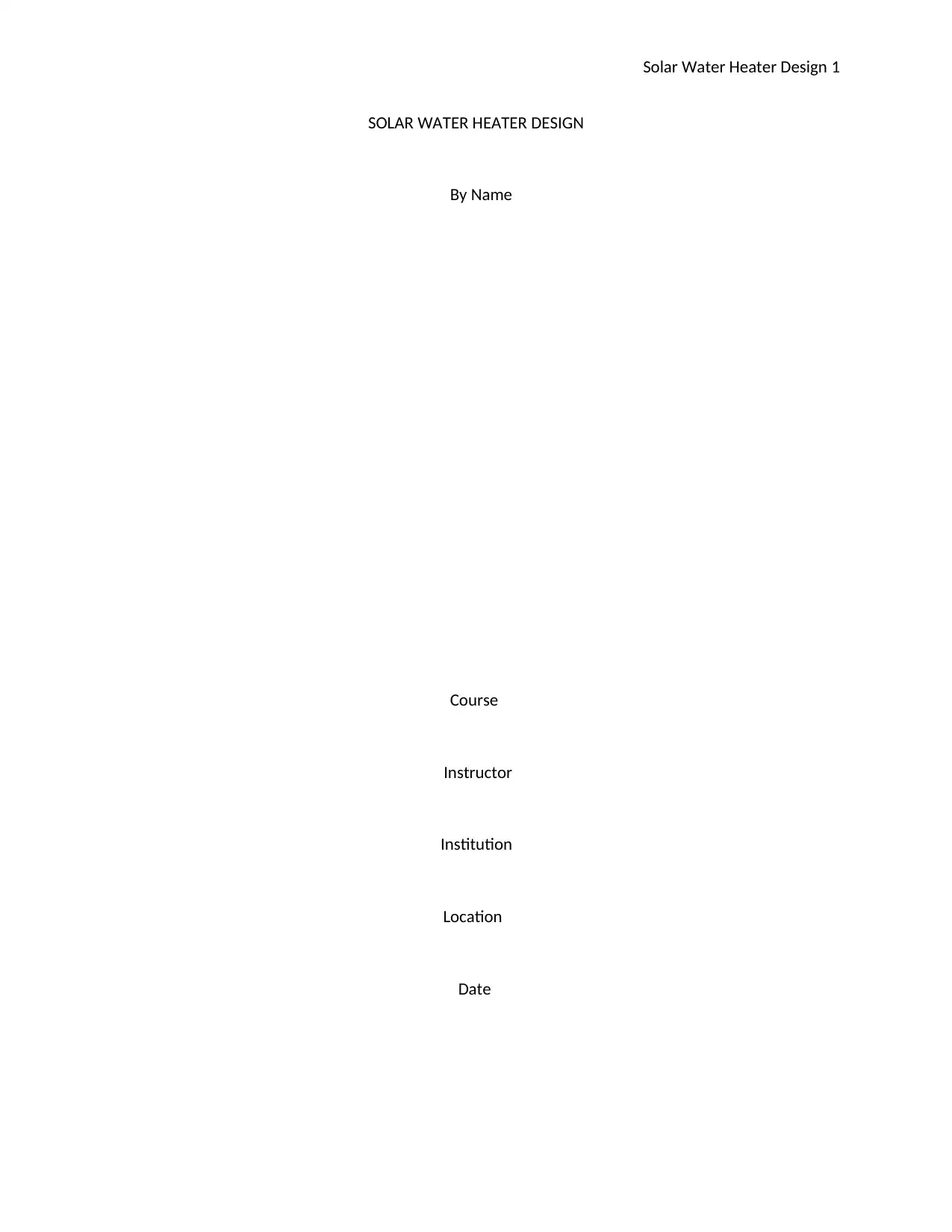
SOLAR WATER HEATER DESIGN
By Name
Course
Instructor
Institution
Location
Date
Solar Water Heater Design 1
By Name
Course
Instructor
Institution
Location
Date
Solar Water Heater Design 1
Paraphrase This Document
Need a fresh take? Get an instant paraphrase of this document with our AI Paraphraser

Title
The design procedure for a residential/commercial solar water-heater system.
Objectives
To study existing hot-water system.
To design efficient hot-water model for both residential and commercial purposes.
To analyze the performance of the hot-water system.
To compare energy consumption between the available design and my design to
determine the savings.
Background information
With global warming and climate change escalating across the world, sustainable and
renewable ways of energy generation are important. By mentioning sustainability and
renewability solar cannot be ignored. Solar is one of the resources that nature has abundantly
provided with and therefore we must make good use of it not only because it is free and natural
but also its numerous advantages such as being clean and green and environmentally friendly
(Wang et al., 2015).
There are several ways of tapping solar energy such as through PV modules and solar
water heating for domestic purposes, industrial and thermal electricity generation. However, this
report only focuses on solar water heating for residential and commercial buildings. solar water
heating for commercial and residential buildings is beneficial in the sense that it reduces
electricity bills as well as reducing reliance on the grid (Dreos et al., 2017).
Solar Water Heater Design 2
The design procedure for a residential/commercial solar water-heater system.
Objectives
To study existing hot-water system.
To design efficient hot-water model for both residential and commercial purposes.
To analyze the performance of the hot-water system.
To compare energy consumption between the available design and my design to
determine the savings.
Background information
With global warming and climate change escalating across the world, sustainable and
renewable ways of energy generation are important. By mentioning sustainability and
renewability solar cannot be ignored. Solar is one of the resources that nature has abundantly
provided with and therefore we must make good use of it not only because it is free and natural
but also its numerous advantages such as being clean and green and environmentally friendly
(Wang et al., 2015).
There are several ways of tapping solar energy such as through PV modules and solar
water heating for domestic purposes, industrial and thermal electricity generation. However, this
report only focuses on solar water heating for residential and commercial buildings. solar water
heating for commercial and residential buildings is beneficial in the sense that it reduces
electricity bills as well as reducing reliance on the grid (Dreos et al., 2017).
Solar Water Heater Design 2

Australia is ranked in the top ten solar countries in the whole world. This is because of its
potential in solar energy. Australia has a combination of dry climate and as well as latitude that
makes it a hub of solar energy. Averagely in the winter season, the continent of Australia gets in
excess of 14MJ per sq. meter per day of insolation. The northern regions surpass 22MJ per sq.
meter per day.
The insolation of the Australian continent far much exceeds the average potential in
Russia, North America, and Europe. Australia's insolation levels can only be compared to the
desert regions of South and North Africa, some areas of Mexico, some parts of the Pacific coast
of South America and the southwestern United States such as the Mojave Desert. Surprisingly,
the areas receiving highest insolation are not inhabited and are far from the populous areas
(Huang et al., 2018).
Despite Australia's extensive annual sunshine, numerous resources and overall
remarkable potential in solar energy, it has done quite little with regards to solar energy tapping
and utilization. This has led to its international criticism.
Australia has several regulations with regards to solar heating/thermal for states and
nationally. This is indicated in a document known as the MRET of 1997.
Literature review
Introduction
Solar water heating refers to the tapping of heat and light from the sun for heating water
using a solar thermal collector. Different regions within the country and across the world use
various configurations at different costs depending on the geographical climates.
Solar Water Heater Design 3
potential in solar energy. Australia has a combination of dry climate and as well as latitude that
makes it a hub of solar energy. Averagely in the winter season, the continent of Australia gets in
excess of 14MJ per sq. meter per day of insolation. The northern regions surpass 22MJ per sq.
meter per day.
The insolation of the Australian continent far much exceeds the average potential in
Russia, North America, and Europe. Australia's insolation levels can only be compared to the
desert regions of South and North Africa, some areas of Mexico, some parts of the Pacific coast
of South America and the southwestern United States such as the Mojave Desert. Surprisingly,
the areas receiving highest insolation are not inhabited and are far from the populous areas
(Huang et al., 2018).
Despite Australia's extensive annual sunshine, numerous resources and overall
remarkable potential in solar energy, it has done quite little with regards to solar energy tapping
and utilization. This has led to its international criticism.
Australia has several regulations with regards to solar heating/thermal for states and
nationally. This is indicated in a document known as the MRET of 1997.
Literature review
Introduction
Solar water heating refers to the tapping of heat and light from the sun for heating water
using a solar thermal collector. Different regions within the country and across the world use
various configurations at different costs depending on the geographical climates.
Solar Water Heater Design 3
⊘ This is a preview!⊘
Do you want full access?
Subscribe today to unlock all pages.

Trusted by 1+ million students worldwide
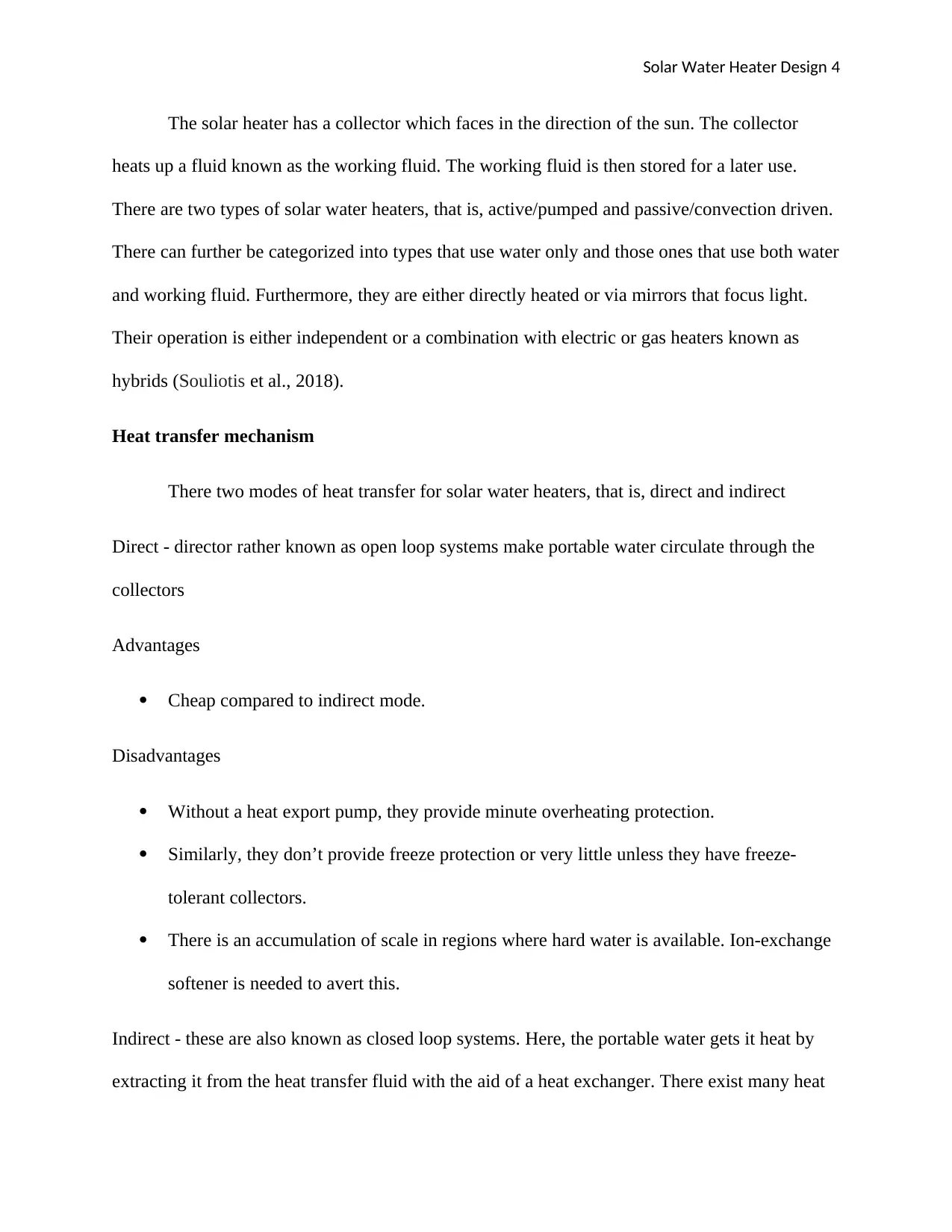
The solar heater has a collector which faces in the direction of the sun. The collector
heats up a fluid known as the working fluid. The working fluid is then stored for a later use.
There are two types of solar water heaters, that is, active/pumped and passive/convection driven.
There can further be categorized into types that use water only and those ones that use both water
and working fluid. Furthermore, they are either directly heated or via mirrors that focus light.
Their operation is either independent or a combination with electric or gas heaters known as
hybrids (Souliotis et al., 2018).
Heat transfer mechanism
There two modes of heat transfer for solar water heaters, that is, direct and indirect
Direct - director rather known as open loop systems make portable water circulate through the
collectors
Advantages
Cheap compared to indirect mode.
Disadvantages
Without a heat export pump, they provide minute overheating protection.
Similarly, they don’t provide freeze protection or very little unless they have freeze-
tolerant collectors.
There is an accumulation of scale in regions where hard water is available. Ion-exchange
softener is needed to avert this.
Indirect - these are also known as closed loop systems. Here, the portable water gets it heat by
extracting it from the heat transfer fluid with the aid of a heat exchanger. There exist many heat
Solar Water Heater Design 4
heats up a fluid known as the working fluid. The working fluid is then stored for a later use.
There are two types of solar water heaters, that is, active/pumped and passive/convection driven.
There can further be categorized into types that use water only and those ones that use both water
and working fluid. Furthermore, they are either directly heated or via mirrors that focus light.
Their operation is either independent or a combination with electric or gas heaters known as
hybrids (Souliotis et al., 2018).
Heat transfer mechanism
There two modes of heat transfer for solar water heaters, that is, direct and indirect
Direct - director rather known as open loop systems make portable water circulate through the
collectors
Advantages
Cheap compared to indirect mode.
Disadvantages
Without a heat export pump, they provide minute overheating protection.
Similarly, they don’t provide freeze protection or very little unless they have freeze-
tolerant collectors.
There is an accumulation of scale in regions where hard water is available. Ion-exchange
softener is needed to avert this.
Indirect - these are also known as closed loop systems. Here, the portable water gets it heat by
extracting it from the heat transfer fluid with the aid of a heat exchanger. There exist many heat
Solar Water Heater Design 4
Paraphrase This Document
Need a fresh take? Get an instant paraphrase of this document with our AI Paraphraser
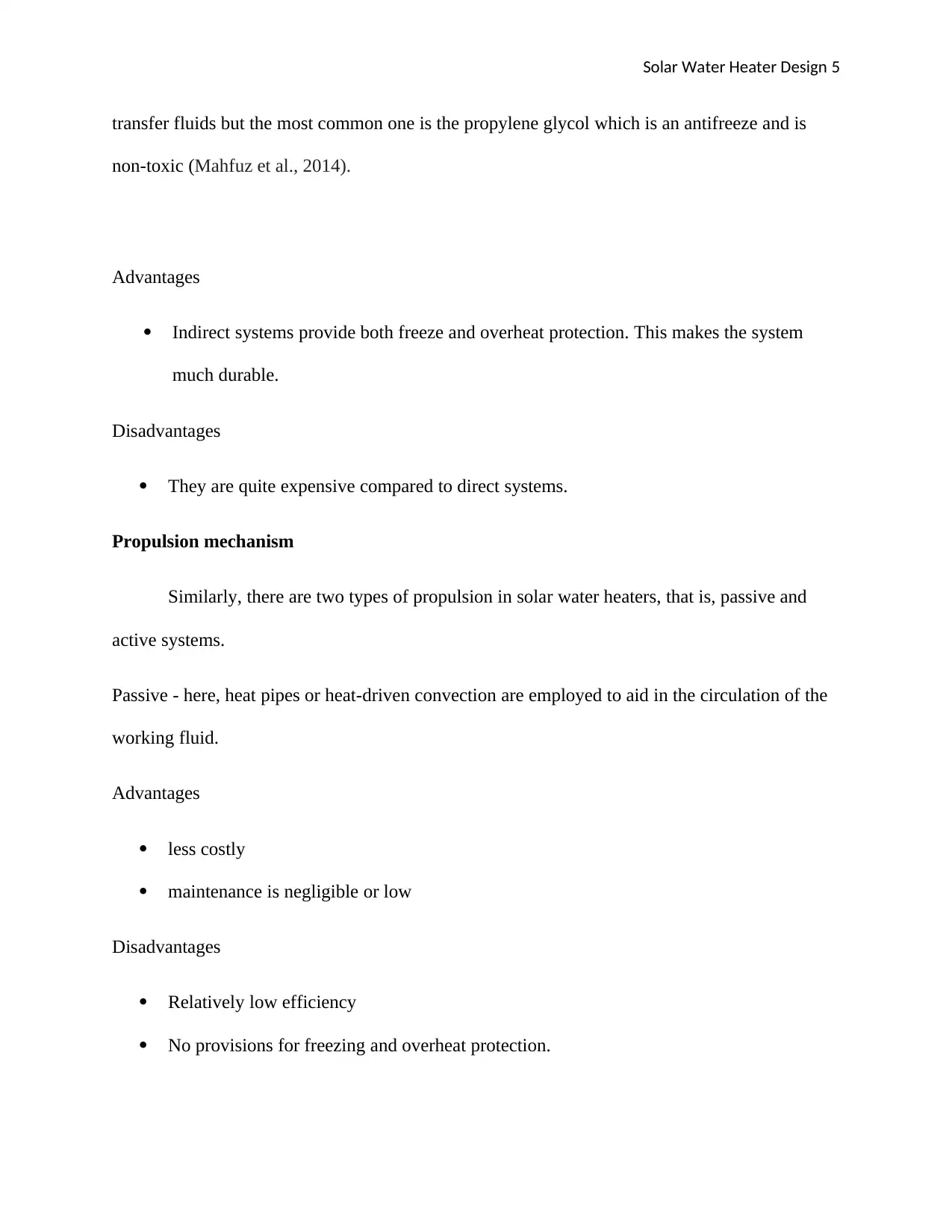
transfer fluids but the most common one is the propylene glycol which is an antifreeze and is
non-toxic (Mahfuz et al., 2014).
Advantages
Indirect systems provide both freeze and overheat protection. This makes the system
much durable.
Disadvantages
They are quite expensive compared to direct systems.
Propulsion mechanism
Similarly, there are two types of propulsion in solar water heaters, that is, passive and
active systems.
Passive - here, heat pipes or heat-driven convection are employed to aid in the circulation of the
working fluid.
Advantages
less costly
maintenance is negligible or low
Disadvantages
Relatively low efficiency
No provisions for freezing and overheat protection.
Solar Water Heater Design 5
non-toxic (Mahfuz et al., 2014).
Advantages
Indirect systems provide both freeze and overheat protection. This makes the system
much durable.
Disadvantages
They are quite expensive compared to direct systems.
Propulsion mechanism
Similarly, there are two types of propulsion in solar water heaters, that is, passive and
active systems.
Passive - here, heat pipes or heat-driven convection are employed to aid in the circulation of the
working fluid.
Advantages
less costly
maintenance is negligible or low
Disadvantages
Relatively low efficiency
No provisions for freezing and overheat protection.
Solar Water Heater Design 5
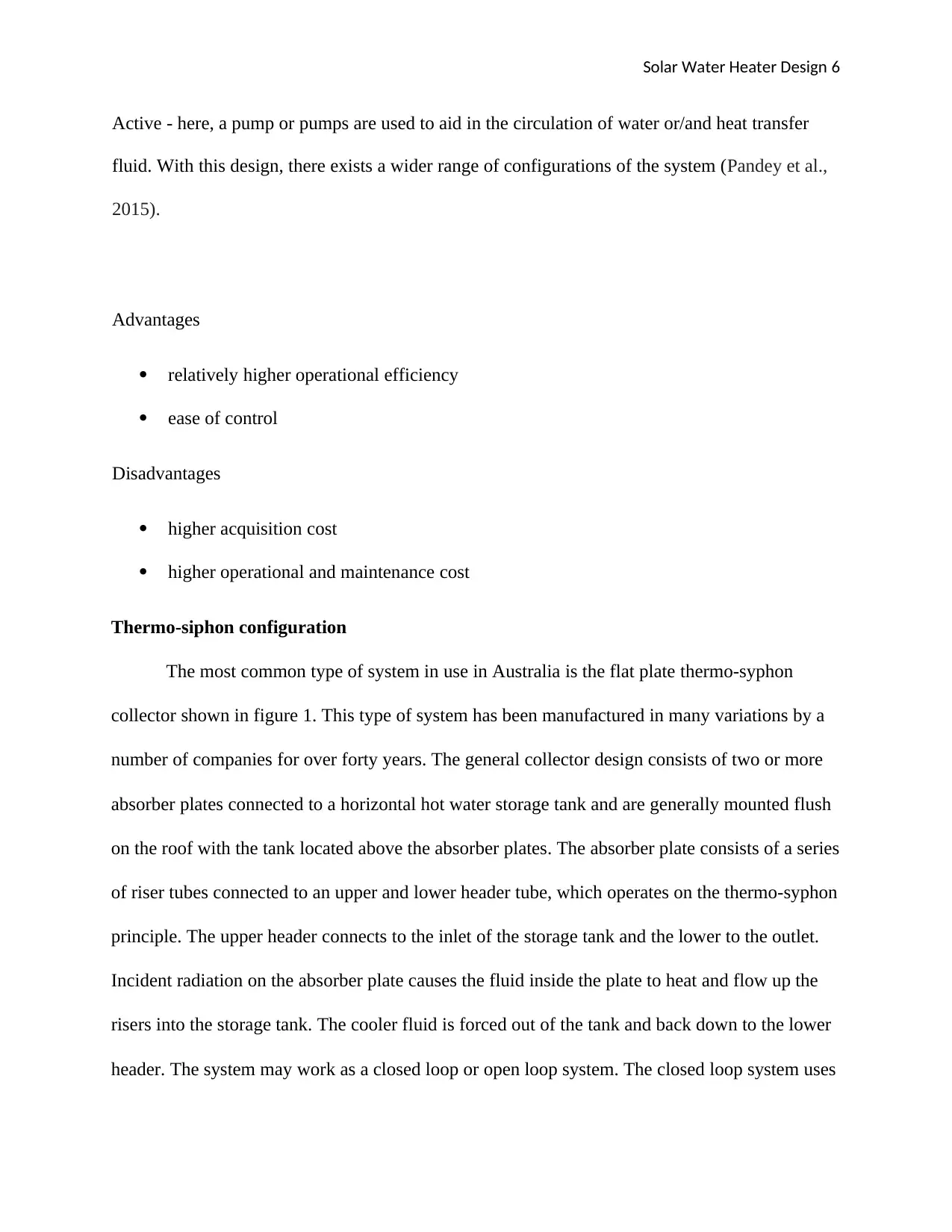
Active - here, a pump or pumps are used to aid in the circulation of water or/and heat transfer
fluid. With this design, there exists a wider range of configurations of the system (Pandey et al.,
2015).
Advantages
relatively higher operational efficiency
ease of control
Disadvantages
higher acquisition cost
higher operational and maintenance cost
Thermo-siphon configuration
The most common type of system in use in Australia is the flat plate thermo-syphon
collector shown in figure 1. This type of system has been manufactured in many variations by a
number of companies for over forty years. The general collector design consists of two or more
absorber plates connected to a horizontal hot water storage tank and are generally mounted flush
on the roof with the tank located above the absorber plates. The absorber plate consists of a series
of riser tubes connected to an upper and lower header tube, which operates on the thermo-syphon
principle. The upper header connects to the inlet of the storage tank and the lower to the outlet.
Incident radiation on the absorber plate causes the fluid inside the plate to heat and flow up the
risers into the storage tank. The cooler fluid is forced out of the tank and back down to the lower
header. The system may work as a closed loop or open loop system. The closed loop system uses
Solar Water Heater Design 6
fluid. With this design, there exists a wider range of configurations of the system (Pandey et al.,
2015).
Advantages
relatively higher operational efficiency
ease of control
Disadvantages
higher acquisition cost
higher operational and maintenance cost
Thermo-siphon configuration
The most common type of system in use in Australia is the flat plate thermo-syphon
collector shown in figure 1. This type of system has been manufactured in many variations by a
number of companies for over forty years. The general collector design consists of two or more
absorber plates connected to a horizontal hot water storage tank and are generally mounted flush
on the roof with the tank located above the absorber plates. The absorber plate consists of a series
of riser tubes connected to an upper and lower header tube, which operates on the thermo-syphon
principle. The upper header connects to the inlet of the storage tank and the lower to the outlet.
Incident radiation on the absorber plate causes the fluid inside the plate to heat and flow up the
risers into the storage tank. The cooler fluid is forced out of the tank and back down to the lower
header. The system may work as a closed loop or open loop system. The closed loop system uses
Solar Water Heater Design 6
⊘ This is a preview!⊘
Do you want full access?
Subscribe today to unlock all pages.

Trusted by 1+ million students worldwide
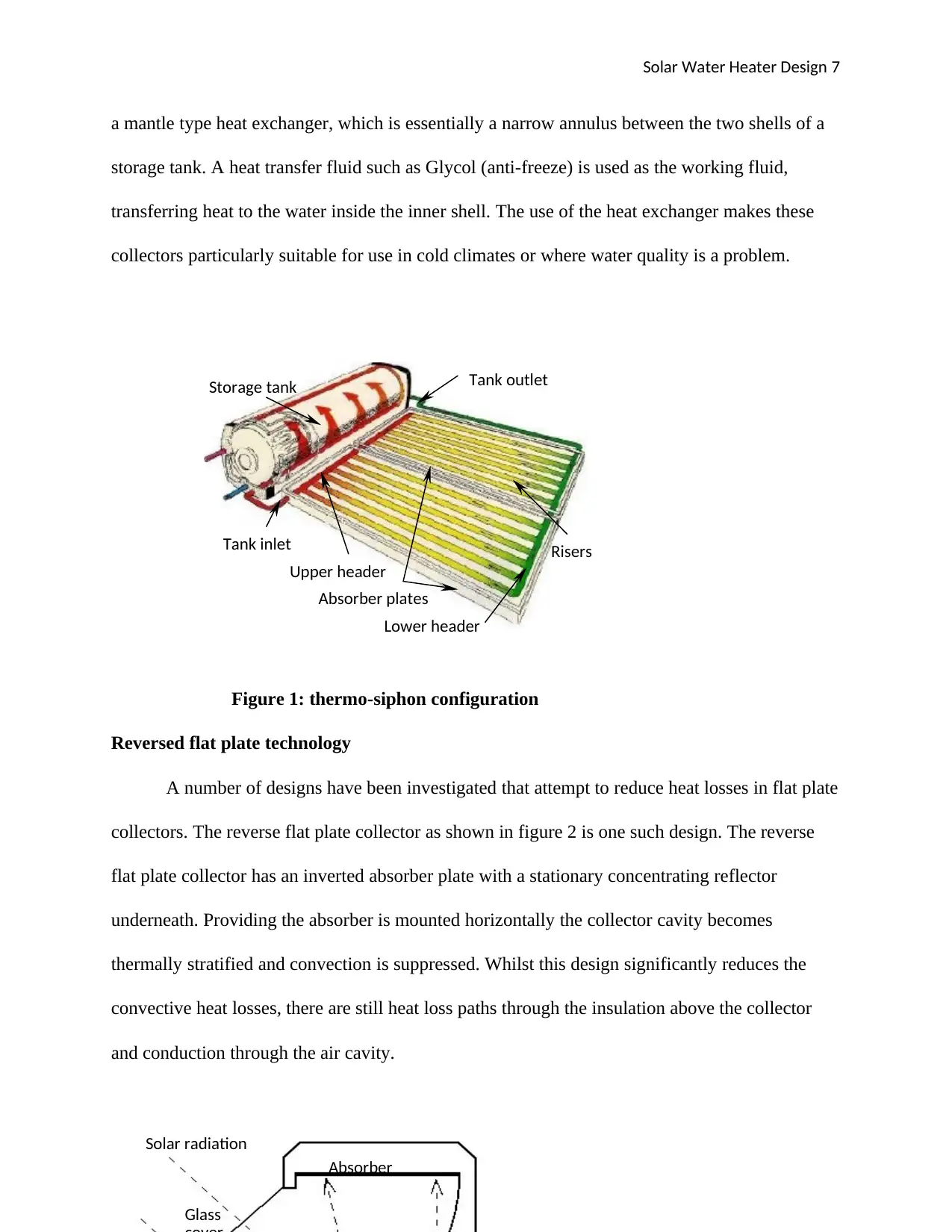
a mantle type heat exchanger, which is essentially a narrow annulus between the two shells of a
storage tank. A heat transfer fluid such as Glycol (anti-freeze) is used as the working fluid,
transferring heat to the water inside the inner shell. The use of the heat exchanger makes these
collectors particularly suitable for use in cold climates or where water quality is a problem.
Figure 1: thermo-siphon configuration
Reversed flat plate technology
A number of designs have been investigated that attempt to reduce heat losses in flat plate
collectors. The reverse flat plate collector as shown in figure 2 is one such design. The reverse
flat plate collector has an inverted absorber plate with a stationary concentrating reflector
underneath. Providing the absorber is mounted horizontally the collector cavity becomes
thermally stratified and convection is suppressed. Whilst this design significantly reduces the
convective heat losses, there are still heat loss paths through the insulation above the collector
and conduction through the air cavity.
Tank outlet
Tank inlet
Storage tank
Upper header
Lower header
Absorber plates
Risers
Glass
Solar radiation
Absorber
Solar Water Heater Design 7
storage tank. A heat transfer fluid such as Glycol (anti-freeze) is used as the working fluid,
transferring heat to the water inside the inner shell. The use of the heat exchanger makes these
collectors particularly suitable for use in cold climates or where water quality is a problem.
Figure 1: thermo-siphon configuration
Reversed flat plate technology
A number of designs have been investigated that attempt to reduce heat losses in flat plate
collectors. The reverse flat plate collector as shown in figure 2 is one such design. The reverse
flat plate collector has an inverted absorber plate with a stationary concentrating reflector
underneath. Providing the absorber is mounted horizontally the collector cavity becomes
thermally stratified and convection is suppressed. Whilst this design significantly reduces the
convective heat losses, there are still heat loss paths through the insulation above the collector
and conduction through the air cavity.
Tank outlet
Tank inlet
Storage tank
Upper header
Lower header
Absorber plates
Risers
Glass
Solar radiation
Absorber
Solar Water Heater Design 7
Paraphrase This Document
Need a fresh take? Get an instant paraphrase of this document with our AI Paraphraser

Figure 2: a reverse flat plate collector schematic
This design allows the collector to be given a seasonal bias by modifying the shape of the
concentrating mirror. The disadvantage from a commercial aspect is that the collector is bulky
and would be difficult to mount on a typical roof.
Bifacial absorber collector
A further development of the reverse flat plat collector is the bifacial collector (see figure
3). This design has been shown to achieve higher efficiencies than other flat plate collectors
under low irradiation conditions.
Figure 3: bifacial plate collector schematic
The design incorporates two identical stationary concentrators with a flat plate absorber
mounted above them. The plate is illuminated on both sides and hence the heat loss path through
the thermal insulation on the rear of the absorber plate is eliminated. The rear of the stationary
concentrators is insulated to reduce heat losses through the back of the collector system.
Designing a solar water heater system
Stationary concentrators
Double sided
absorber plate
Mirror Solar Water Heater Design 8
This design allows the collector to be given a seasonal bias by modifying the shape of the
concentrating mirror. The disadvantage from a commercial aspect is that the collector is bulky
and would be difficult to mount on a typical roof.
Bifacial absorber collector
A further development of the reverse flat plat collector is the bifacial collector (see figure
3). This design has been shown to achieve higher efficiencies than other flat plate collectors
under low irradiation conditions.
Figure 3: bifacial plate collector schematic
The design incorporates two identical stationary concentrators with a flat plate absorber
mounted above them. The plate is illuminated on both sides and hence the heat loss path through
the thermal insulation on the rear of the absorber plate is eliminated. The rear of the stationary
concentrators is insulated to reduce heat losses through the back of the collector system.
Designing a solar water heater system
Stationary concentrators
Double sided
absorber plate
Mirror Solar Water Heater Design 8
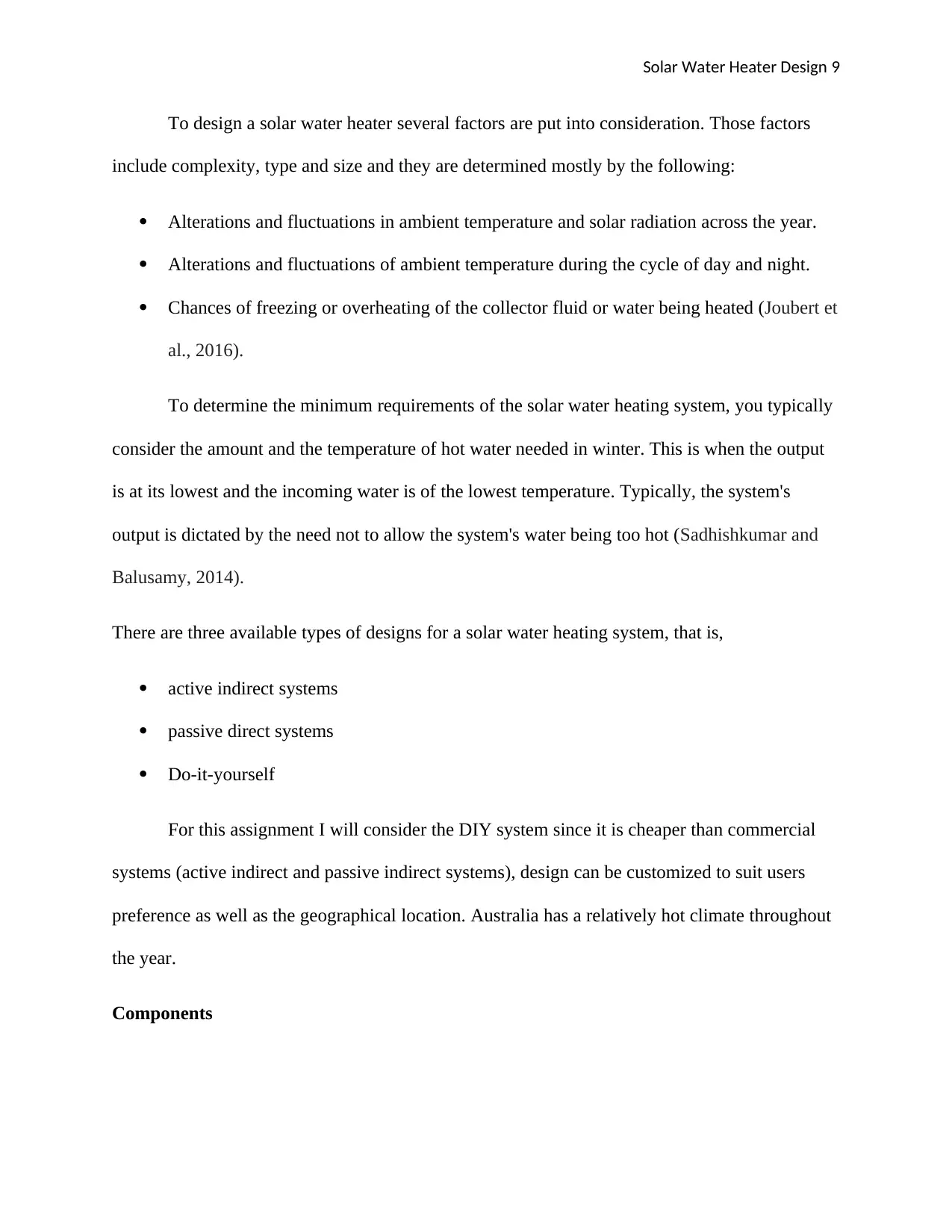
To design a solar water heater several factors are put into consideration. Those factors
include complexity, type and size and they are determined mostly by the following:
Alterations and fluctuations in ambient temperature and solar radiation across the year.
Alterations and fluctuations of ambient temperature during the cycle of day and night.
Chances of freezing or overheating of the collector fluid or water being heated (Joubert et
al., 2016).
To determine the minimum requirements of the solar water heating system, you typically
consider the amount and the temperature of hot water needed in winter. This is when the output
is at its lowest and the incoming water is of the lowest temperature. Typically, the system's
output is dictated by the need not to allow the system's water being too hot (Sadhishkumar and
Balusamy, 2014).
There are three available types of designs for a solar water heating system, that is,
active indirect systems
passive direct systems
Do-it-yourself
For this assignment I will consider the DIY system since it is cheaper than commercial
systems (active indirect and passive indirect systems), design can be customized to suit users
preference as well as the geographical location. Australia has a relatively hot climate throughout
the year.
Components
Solar Water Heater Design 9
include complexity, type and size and they are determined mostly by the following:
Alterations and fluctuations in ambient temperature and solar radiation across the year.
Alterations and fluctuations of ambient temperature during the cycle of day and night.
Chances of freezing or overheating of the collector fluid or water being heated (Joubert et
al., 2016).
To determine the minimum requirements of the solar water heating system, you typically
consider the amount and the temperature of hot water needed in winter. This is when the output
is at its lowest and the incoming water is of the lowest temperature. Typically, the system's
output is dictated by the need not to allow the system's water being too hot (Sadhishkumar and
Balusamy, 2014).
There are three available types of designs for a solar water heating system, that is,
active indirect systems
passive direct systems
Do-it-yourself
For this assignment I will consider the DIY system since it is cheaper than commercial
systems (active indirect and passive indirect systems), design can be customized to suit users
preference as well as the geographical location. Australia has a relatively hot climate throughout
the year.
Components
Solar Water Heater Design 9
⊘ This is a preview!⊘
Do you want full access?
Subscribe today to unlock all pages.

Trusted by 1+ million students worldwide
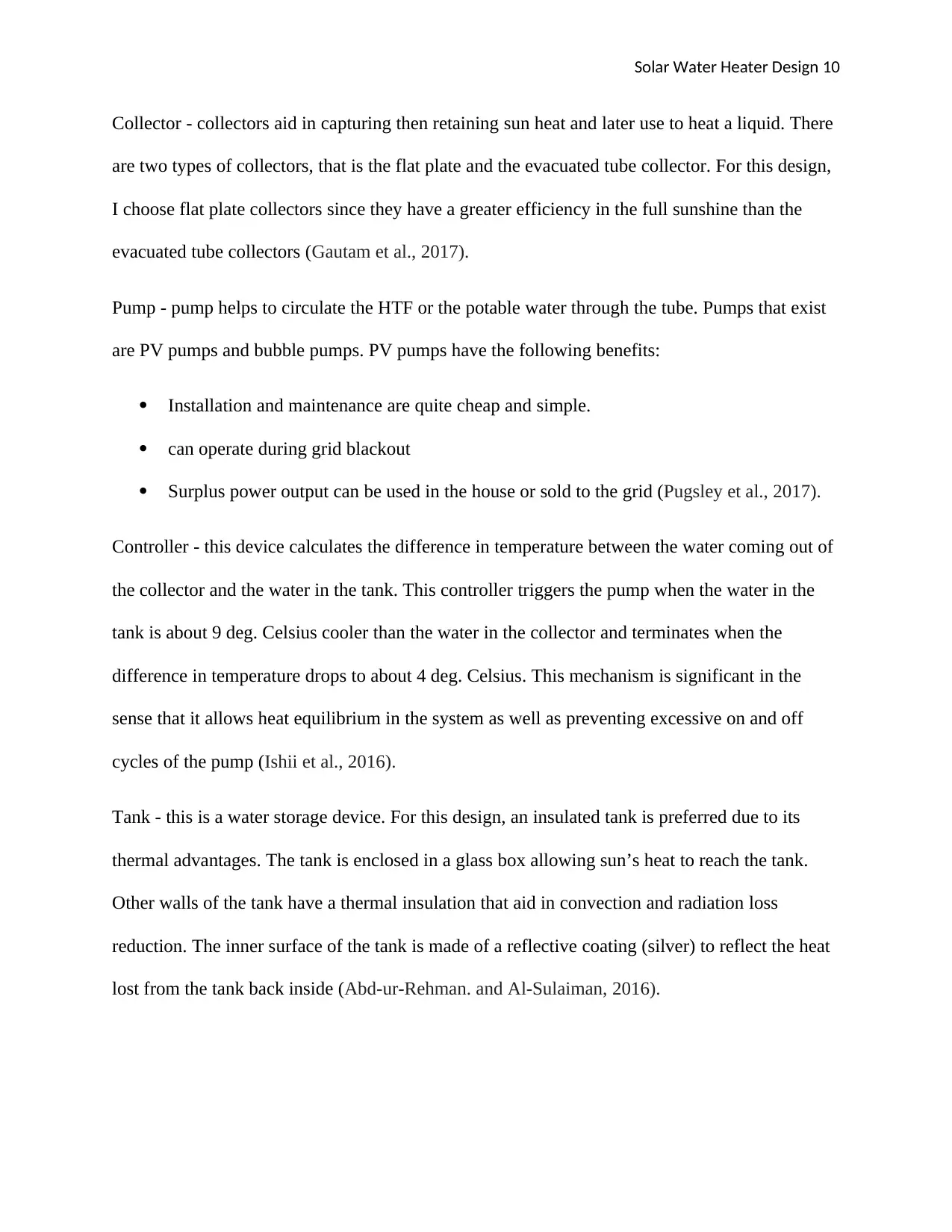
Collector - collectors aid in capturing then retaining sun heat and later use to heat a liquid. There
are two types of collectors, that is the flat plate and the evacuated tube collector. For this design,
I choose flat plate collectors since they have a greater efficiency in the full sunshine than the
evacuated tube collectors (Gautam et al., 2017).
Pump - pump helps to circulate the HTF or the potable water through the tube. Pumps that exist
are PV pumps and bubble pumps. PV pumps have the following benefits:
Installation and maintenance are quite cheap and simple.
can operate during grid blackout
Surplus power output can be used in the house or sold to the grid (Pugsley et al., 2017).
Controller - this device calculates the difference in temperature between the water coming out of
the collector and the water in the tank. This controller triggers the pump when the water in the
tank is about 9 deg. Celsius cooler than the water in the collector and terminates when the
difference in temperature drops to about 4 deg. Celsius. This mechanism is significant in the
sense that it allows heat equilibrium in the system as well as preventing excessive on and off
cycles of the pump (Ishii et al., 2016).
Tank - this is a water storage device. For this design, an insulated tank is preferred due to its
thermal advantages. The tank is enclosed in a glass box allowing sun’s heat to reach the tank.
Other walls of the tank have a thermal insulation that aid in convection and radiation loss
reduction. The inner surface of the tank is made of a reflective coating (silver) to reflect the heat
lost from the tank back inside (Abd-ur-Rehman. and Al-Sulaiman, 2016).
Solar Water Heater Design 10
are two types of collectors, that is the flat plate and the evacuated tube collector. For this design,
I choose flat plate collectors since they have a greater efficiency in the full sunshine than the
evacuated tube collectors (Gautam et al., 2017).
Pump - pump helps to circulate the HTF or the potable water through the tube. Pumps that exist
are PV pumps and bubble pumps. PV pumps have the following benefits:
Installation and maintenance are quite cheap and simple.
can operate during grid blackout
Surplus power output can be used in the house or sold to the grid (Pugsley et al., 2017).
Controller - this device calculates the difference in temperature between the water coming out of
the collector and the water in the tank. This controller triggers the pump when the water in the
tank is about 9 deg. Celsius cooler than the water in the collector and terminates when the
difference in temperature drops to about 4 deg. Celsius. This mechanism is significant in the
sense that it allows heat equilibrium in the system as well as preventing excessive on and off
cycles of the pump (Ishii et al., 2016).
Tank - this is a water storage device. For this design, an insulated tank is preferred due to its
thermal advantages. The tank is enclosed in a glass box allowing sun’s heat to reach the tank.
Other walls of the tank have a thermal insulation that aid in convection and radiation loss
reduction. The inner surface of the tank is made of a reflective coating (silver) to reflect the heat
lost from the tank back inside (Abd-ur-Rehman. and Al-Sulaiman, 2016).
Solar Water Heater Design 10
Paraphrase This Document
Need a fresh take? Get an instant paraphrase of this document with our AI Paraphraser
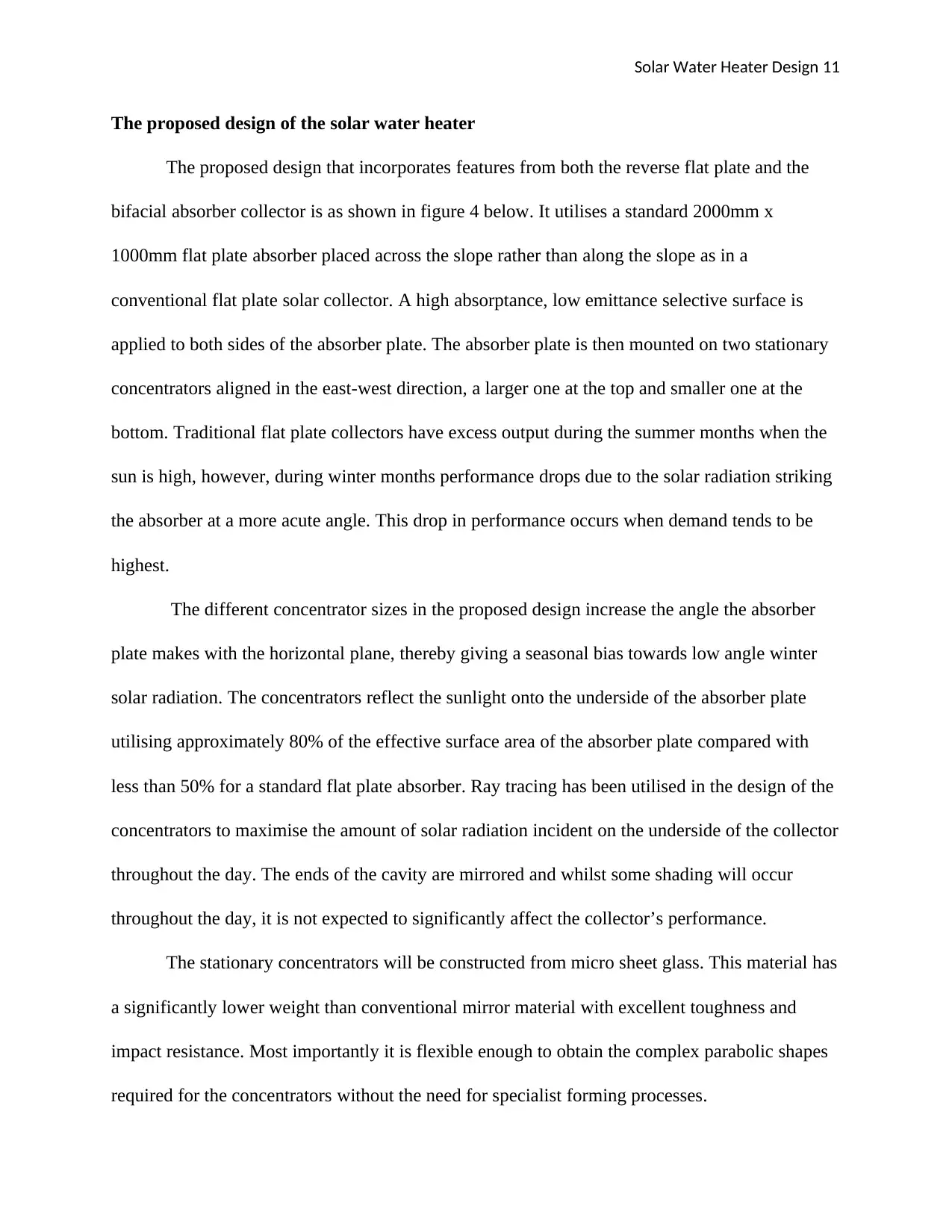
The proposed design of the solar water heater
The proposed design that incorporates features from both the reverse flat plate and the
bifacial absorber collector is as shown in figure 4 below. It utilises a standard 2000mm x
1000mm flat plate absorber placed across the slope rather than along the slope as in a
conventional flat plate solar collector. A high absorptance, low emittance selective surface is
applied to both sides of the absorber plate. The absorber plate is then mounted on two stationary
concentrators aligned in the east-west direction, a larger one at the top and smaller one at the
bottom. Traditional flat plate collectors have excess output during the summer months when the
sun is high, however, during winter months performance drops due to the solar radiation striking
the absorber at a more acute angle. This drop in performance occurs when demand tends to be
highest.
The different concentrator sizes in the proposed design increase the angle the absorber
plate makes with the horizontal plane, thereby giving a seasonal bias towards low angle winter
solar radiation. The concentrators reflect the sunlight onto the underside of the absorber plate
utilising approximately 80% of the effective surface area of the absorber plate compared with
less than 50% for a standard flat plate absorber. Ray tracing has been utilised in the design of the
concentrators to maximise the amount of solar radiation incident on the underside of the collector
throughout the day. The ends of the cavity are mirrored and whilst some shading will occur
throughout the day, it is not expected to significantly affect the collector’s performance.
The stationary concentrators will be constructed from micro sheet glass. This material has
a significantly lower weight than conventional mirror material with excellent toughness and
impact resistance. Most importantly it is flexible enough to obtain the complex parabolic shapes
required for the concentrators without the need for specialist forming processes.
Solar Water Heater Design 11
The proposed design that incorporates features from both the reverse flat plate and the
bifacial absorber collector is as shown in figure 4 below. It utilises a standard 2000mm x
1000mm flat plate absorber placed across the slope rather than along the slope as in a
conventional flat plate solar collector. A high absorptance, low emittance selective surface is
applied to both sides of the absorber plate. The absorber plate is then mounted on two stationary
concentrators aligned in the east-west direction, a larger one at the top and smaller one at the
bottom. Traditional flat plate collectors have excess output during the summer months when the
sun is high, however, during winter months performance drops due to the solar radiation striking
the absorber at a more acute angle. This drop in performance occurs when demand tends to be
highest.
The different concentrator sizes in the proposed design increase the angle the absorber
plate makes with the horizontal plane, thereby giving a seasonal bias towards low angle winter
solar radiation. The concentrators reflect the sunlight onto the underside of the absorber plate
utilising approximately 80% of the effective surface area of the absorber plate compared with
less than 50% for a standard flat plate absorber. Ray tracing has been utilised in the design of the
concentrators to maximise the amount of solar radiation incident on the underside of the collector
throughout the day. The ends of the cavity are mirrored and whilst some shading will occur
throughout the day, it is not expected to significantly affect the collector’s performance.
The stationary concentrators will be constructed from micro sheet glass. This material has
a significantly lower weight than conventional mirror material with excellent toughness and
impact resistance. Most importantly it is flexible enough to obtain the complex parabolic shapes
required for the concentrators without the need for specialist forming processes.
Solar Water Heater Design 11
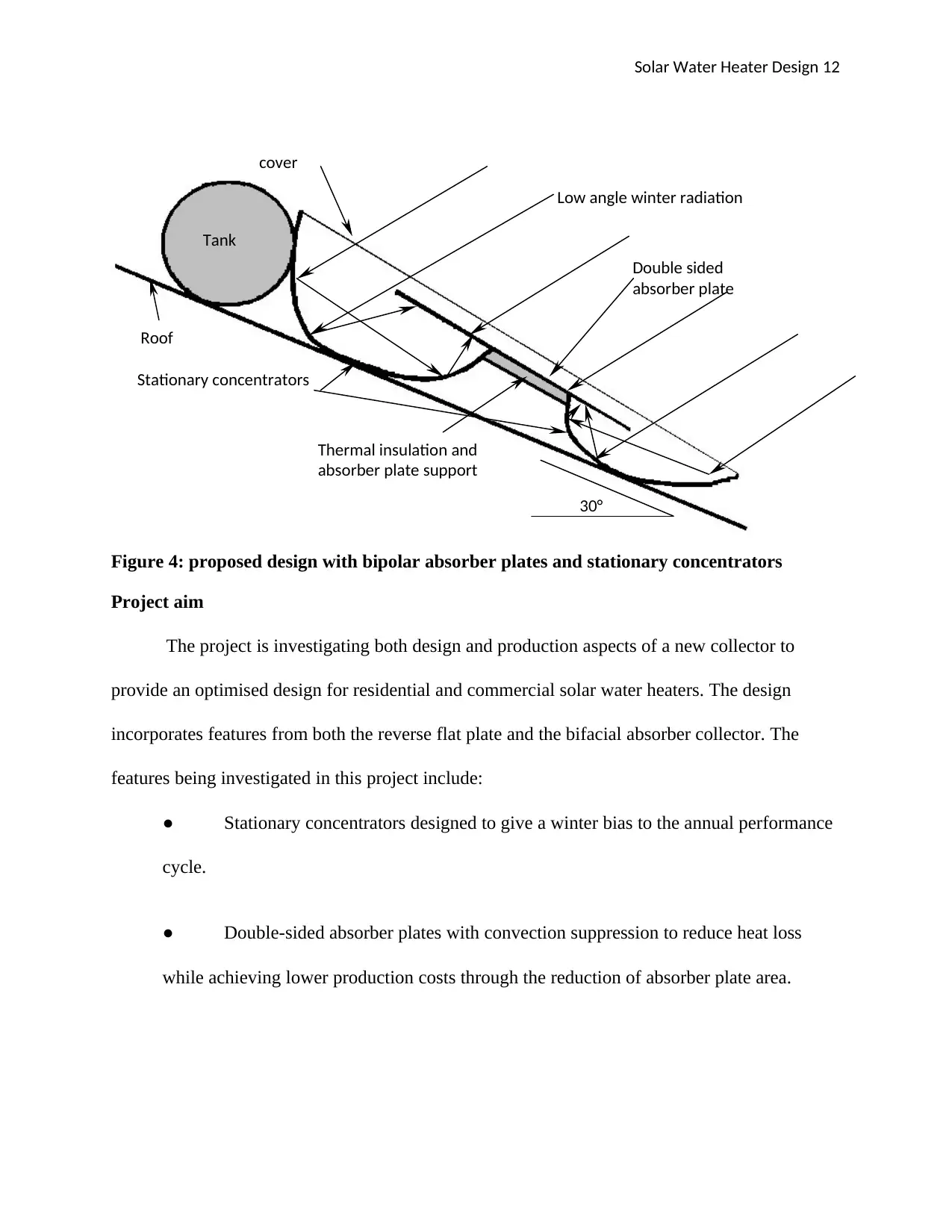
Figure 4: proposed design with bipolar absorber plates and stationary concentrators
Project aim
The project is investigating both design and production aspects of a new collector to
provide an optimised design for residential and commercial solar water heaters. The design
incorporates features from both the reverse flat plate and the bifacial absorber collector. The
features being investigated in this project include:
● Stationary concentrators designed to give a winter bias to the annual performance
cycle.
● Double-sided absorber plates with convection suppression to reduce heat loss
while achieving lower production costs through the reduction of absorber plate area.
Thermal insulation and
absorber plate support
Low angle winter radiation
Stationary concentrators
Double sided
absorber plate
30°
Roof
cover
Tank
Solar Water Heater Design 12
Project aim
The project is investigating both design and production aspects of a new collector to
provide an optimised design for residential and commercial solar water heaters. The design
incorporates features from both the reverse flat plate and the bifacial absorber collector. The
features being investigated in this project include:
● Stationary concentrators designed to give a winter bias to the annual performance
cycle.
● Double-sided absorber plates with convection suppression to reduce heat loss
while achieving lower production costs through the reduction of absorber plate area.
Thermal insulation and
absorber plate support
Low angle winter radiation
Stationary concentrators
Double sided
absorber plate
30°
Roof
cover
Tank
Solar Water Heater Design 12
⊘ This is a preview!⊘
Do you want full access?
Subscribe today to unlock all pages.

Trusted by 1+ million students worldwide
1 out of 21
Your All-in-One AI-Powered Toolkit for Academic Success.
+13062052269
info@desklib.com
Available 24*7 on WhatsApp / Email
![[object Object]](/_next/static/media/star-bottom.7253800d.svg)
Unlock your academic potential
Copyright © 2020–2025 A2Z Services. All Rights Reserved. Developed and managed by ZUCOL.
